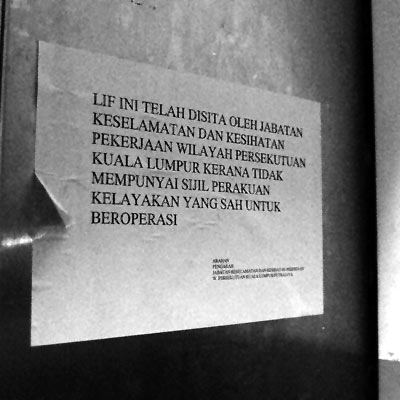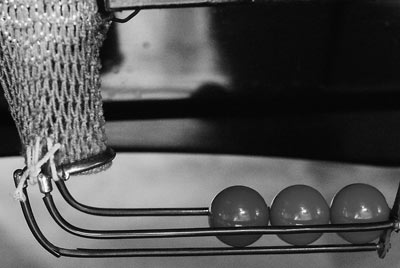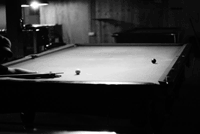
My new Minolta AF/Sony family picture! (Click for bigger picture.)
From left to right, back row: Peleng 8mm F3.5 circular fisheye (with M42 to A-mount adapter), Sigma 17-35mm F2.8-4 EX full-frame ultrawide lens (NEW!), Sony HVL-F56AM flash behind, Vivitar Series 1 28-105mm F2.8-3.8 push-pull lens, Tamron 200-400mm F5.6 push-pull lens, Cosina 70-210mm F2.8-4 push-pull lens, Minolta 70-210mm F4 ‘beercan‘ lens, Sigma 70-210mm F4-5.6 push-pull ‘softie‘ lens.
From left to right, front row: Sony Alpha 700 with Tamron 1.4x teleconverter, Minolta 50mm F1.4 (pre-RS), Minolta Dynax 7 with Kenko Teleplus 2x teleconverter.
The Sony 18-70mm F3.5-5.6 DT kit lens and Minolta 28-80mm F3.5-5.6 silver kit lens (for the Dynax 7) have since been sold. Yay!
(I’d also like to thank KJ for scouting and finding the secondhand Tamron 200-400mm F5.6 for me; and thanks also to Yik Sen who bought it bundled with a film body and sold me the lens.)

All the A-mount bodies I’ve ever owned! Left to right: Sony Alpha 700, Sony Alpha 100, Minolta Dynax 7. The A100 has since been sold to Lex, with the Sony 18-70mm F3.5-5.6 DT kit lens.
I wouldn’t have sold the kit lens if I had a choice, but Lex didn’t have a lens to use on it otherwise.
While I don’t particularly fancy the focal lengths that the kit lens covers, I realize that I do need it, and that it is amazingly good for its price. It’s not a softie like the horrid Canon 18-55mm F3.5-5.6 USM (and maybe its updated IS counterpart).
How do I know the Sony kit lens is sharp?
Even after I put it through teleconverters, it does not become soft! That is usually the ultimate test for lenses. Chromatic aberration is very rare, and so is flare.

One of the most astounding shots I ever shot with the Sony 18-70mm F3.5-5.6 DT kit lens on the Sony A100. I’m amazed how, with the proper lighting, it can look astoundingly sharp. I always felt its resolution wasn’t so great even stopped down for focusing on far-away landscapes, but for closeups, this is amazing.

100% crop of the same picture.
Of course, selling off the Sony kit lens meant that I had no more APS-C cropped factor lenses, no more Sony lenses, no more ADI (Automatic Distance Integration) D-lenses, no more plastic mount lenses, and no more lenses with apertures from F3.5-5.6.

And so, I needed to get a replacement, and what better than the Sigma 17-35mm F2.8-4 EX full-frame ultrawide lens?
Of course, on the A700, it becomes a standard wide, cropped down to a meager 26.5-52.5mm equivalent. However, it’s oodles brighter than the kit lens, which is already F5.6 at 35mm! Also, 17mm F2.8 on a full-frame is brighter than a Sony 11-18mm F4.5-5.6 DT at 11mm F4.5 on an A100/A700 (both giving about the same field of view.)
This is the older EX version, not the EX DG version, which I would’ve preferred because it has a 77mm filter thread. This oldie is not optimized for digital SLRs and thus has noticeable light falloff. Fortunately, I can stack a 82mm UV, 82-77mm step down ring, 77mm infrared filter, on the A100/A700 and have no vignetting due to the crop factor!
It is, however, a D lens and supports ADI, so it can tell the camera what is the focused distance so that the flash can work more accurately.
I also like how its rings turn the same way as my Minolta and Sony lenses; anti-clockwise from back to infinity; anti-clockwise from back to wide. This makes sense because turning a screw clockwise would make a screw enter deeper; thus, the front element would enter deeper and focus on infinity; likewise for zoom lenses, which extend when you turn it anti-clockwise from the front. Thus they work exactly like screws do; anti-clockwise to loosen/extend, clockwise to tighten/shorten.

(This picture is not meant to demonstrate Sigma yellow, a condition associated with Sigma lenses; I shot it with this white balance, intended.)
I got this for a great bargain secondhand; a 17-35mm full-frame constant F2.8 would cost in the prohibitive 4 digits; a Tamron 17-50mm F2.8 DT wouldn’t work on full-frame; a 16mm F2.8 or anything wider would balloon in price substantially.
Thus, a 17-35mm F2.8-4 is the cheapest rectilinear ultrawide you can get for full-frame. Minolta made one in conjunction with Tamron, but I couldn’t find that one.
I don’t know why, but it felt wider than the Tamron 17-50mm F2.8 DT, with more obvious perspective distortion on the sides. Or I could just be imagining things. I didn’t feel the 17-50mm gave enough distortion.
I also considered the cheap Tamron 19-35mm F3.5-4.5 full-frame lens, but I figured my A700 would love me more for putting a F2.8 lens on it. After all, the A700 has an extra F2.8 sensor for better AF with F2.8 lenses.
Shots from the Sigma on my full-frame Dynax 7 will come when I’m done with a roll. 🙂

The Sigma introduces a lot of light falloff when shot at F2.8, which can add dramatic effect.

17mm F2.8 0.8s ISO6400 with infrared filter. Handheld baby! Note the light falloff.

The A700 is very capable of infrared, what with its ISO6400 capabilities! 50mm F2.2 2 seconds ISO6400 propped on a balcony in Masjid Jamek STAR LRT. The blurry thing on the bottom-left of the frame is the balcony, out of focus. 😀
I used a 950-nanometer-cutoff pure infrared filter, because my Hoya R72 would let in too much red and it would not have the true infrared look anymore.

50mm F1.4 1/6s ISO6400 handheld in black-and-white mode with infrared filter. Amazingly, the A700 can autofocus with it!

50mm F1.4 1/8000s ISO100 in black-and-white mode, without infrared filter. That’s how scorching the sun was.
The histograms of both pictures are very different; thus, I cannot accurately measure how many stops you’d have to add to shoot infrared. Already it’s hard to match histograms while shooting infrared because different things reflect infrared differently.
I then did a comparison with the A100, to see which was more sensitive. The A100 was 2 stops more sensitive!
To shoot the same scene with the A100, I’d use 50mm F1.4 1/6s ISO1600. They would be just as noisy anyway in black-and-white, which is fine because infrared film was grainy. Therefore, I get the same shutter speeds if I go to ISO6400 on the A700 and ISO1600 on the A100, both about equally as noisy in black-and-white.
However, I would say the A700 is more suited for infrared photography because it can autofocus better in infrared.

What else can infrared do? Well, our eyes do not reflect infrared, and the only way to get one’s eyes lit up in infrared is if you stare at the sun. DO NOT STARE AT THE SUN!

The Sony A100 and A700 do black-and-white exceptionally well; turn down the contrast and you get a silver halide print; turn it up and you get this.
I’m not familiar with black-and-white film though, so I can’t tell you what film that looks like. I do know that I like it, though. 🙂
Heck, I shot the same scene in color and tried to convert it to black-and-white, but it lost a lot of range and contrast which Photoshopping could not fix.

Up next: Feeling lucky, punk?































































